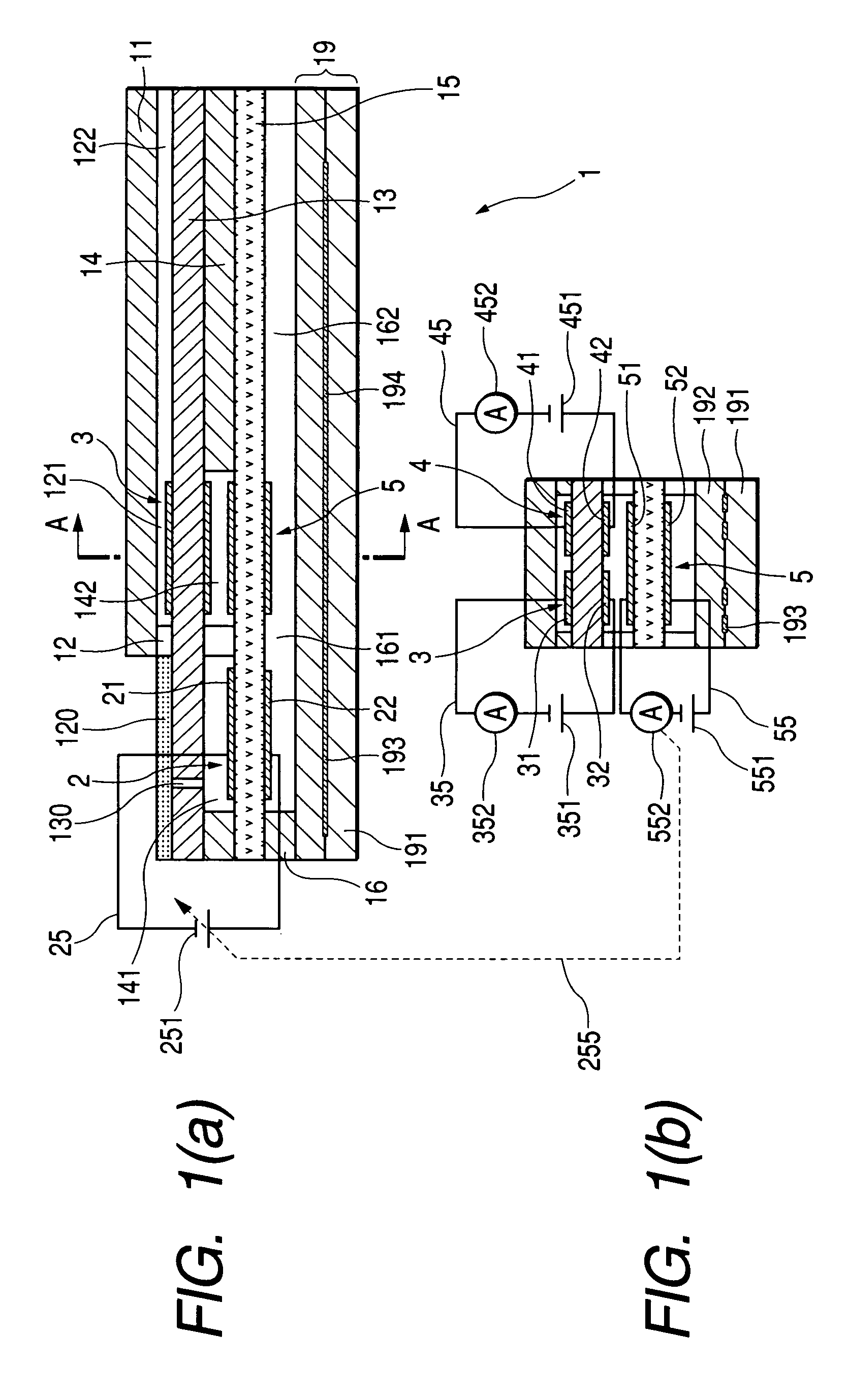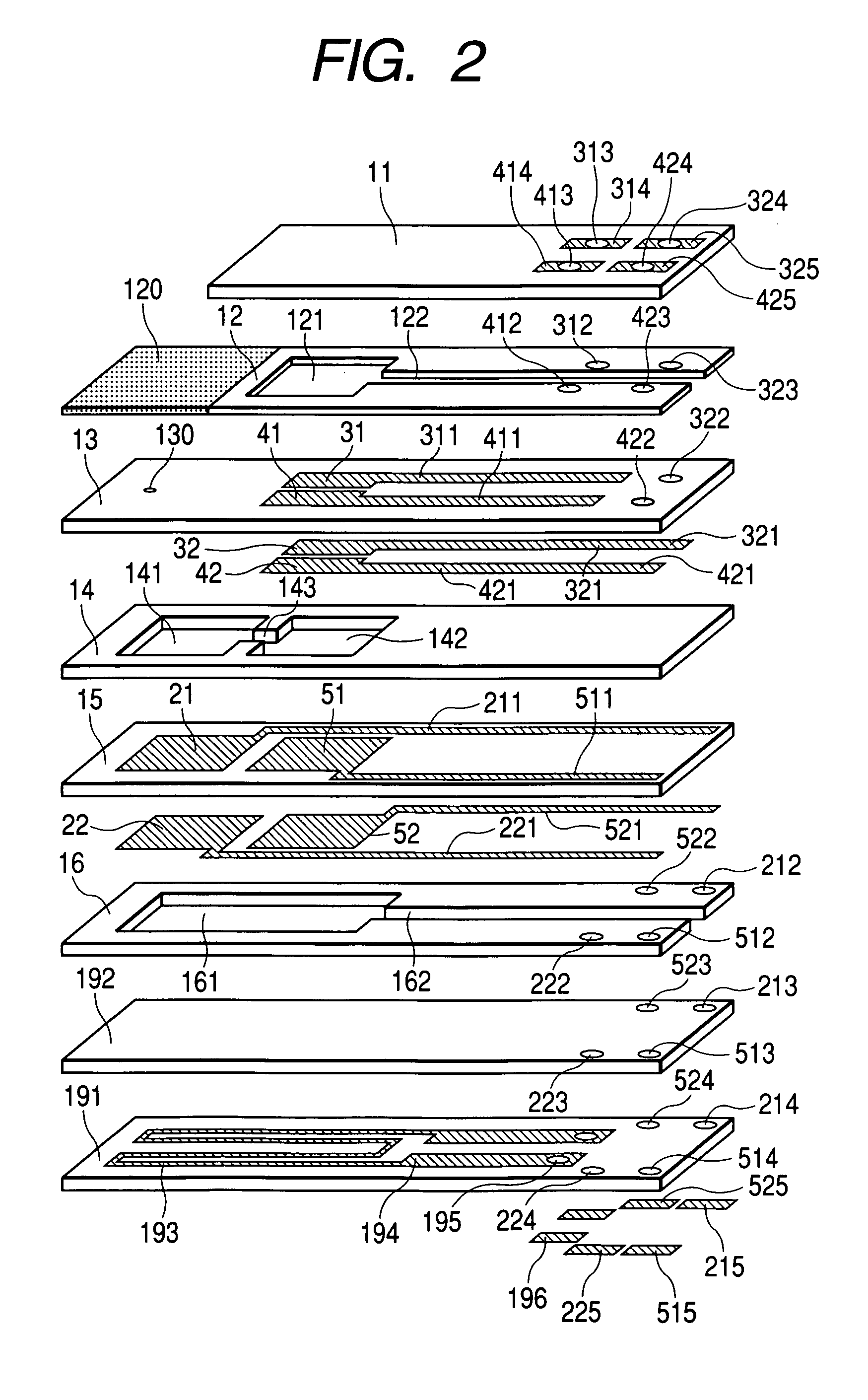Hydrogen-containing gas measurement sensor element and measuring method using same
a technology of hydrogen-containing gas and sensor element, which is applied in the direction of liquid/fluent solid measurement, electrochemical variables, instruments, etc., can solve the problems of severe emission regulation, serious problems with modern life, and auto exhaust fumes, so as to facilitate use and minimize adverse effects
- Summary
- Abstract
- Description
- Claims
- Application Information
AI Technical Summary
Benefits of technology
Problems solved by technology
Method used
Image
Examples
first embodiment
[0054]Referring to the drawings, wherein like reference numbers refer to like parts in several views, particularly to FIGS. 1(a), 1(b), and 2, there is shown a gas sensor element 1 according to the invention which may be installed in an exhaust pipe of an internal combustion engine to measure concentrations of a hydrocarbon (HC) gas and a hydrogen gas contained in exhaust emissions of the engine for use in engine burning control and / or catalytic systems.
[0055]The gas sensor element 1 includes generally first and second measurement gas chambers 141 and 142 into which gases to be measured (will also be referred to as measurement gases below) are introduced, subjected to a given diffusion resistance, an oxygen pump cell 2 exposed to the first measurement gas chamber 141, and first and second hydrogen-containing gas measurement cells 3 and 4 exposed to the second measurement gas chamber 142. The oxygen pump cell 2 is made up of an oxygen ion-conductive solid electrolyte plate 15, an ele...
second embodiment
[0093]FIGS. 3(a) and 3(b) show the gas sensor element 1 according to the invention which is designed to develop an electromotive force at the electrodes 51 and 52 of the oxygen monitor cell 5 as a function of concentration of oxygen within the measurement gases.
[0094]The oxygen monitor cell 5 connects electrically to the monitor circuit 55 equipped with a voltmeter 553. The electrode 51 of the oxygen monitor cell 5 is exposed to the second measurement gas chamber 142, while the electrode 52 is exposed to the first reference gas chamber 161. The electromotive force is creased, as expressed by the Nernst's equation, between the electrodes 51 and 52 as a function of a difference in concentration of oxygen between the second measurement gas chamber 142 and the first reference gas chamber 161. The first reference gas chamber 161 is kept constant in concentration of oxygen, so that the electromotive force produced between the electrodes 51 and 52 indicates the concentration of oxygen with...
third embodiment
[0097]FIGS. 4(a) and 4(b) show the gas sensor element 1 according to the invention which has a three-cell structure equipped with the oxygen pump cell 2 and the first and second hydrogen-containing gas measurement cells 3 and 4.
[0098]Specifically, the gas sensor element 1 of this embodiment is identical in structure with the one of the first embodiment from which the oxygen monitor cell 5 is removed. The feedback control circuit 256 is disposed between the current detector 252 of the pump circuit 25 connecting to the oxygen pump cell 2 and the variable power supply 251.
[0099]FIG. 5 illustrates a relation between voltage Vp applied to the oxygen pump cell 2 and the resulting current Ip flowing through the oxygen pump cell 2. The graph shows that the oxygen pump cell 2 produces the constant current Ip as a function of the concentration of oxygen within a given limiting current range defined by a portion of each curve extending parallel to an abscissa axis (i.e., a Vp-axis). The limiti...
PUM
 Login to View More
Login to View More Abstract
Description
Claims
Application Information
 Login to View More
Login to View More - R&D
- Intellectual Property
- Life Sciences
- Materials
- Tech Scout
- Unparalleled Data Quality
- Higher Quality Content
- 60% Fewer Hallucinations
Browse by: Latest US Patents, China's latest patents, Technical Efficacy Thesaurus, Application Domain, Technology Topic, Popular Technical Reports.
© 2025 PatSnap. All rights reserved.Legal|Privacy policy|Modern Slavery Act Transparency Statement|Sitemap|About US| Contact US: help@patsnap.com



